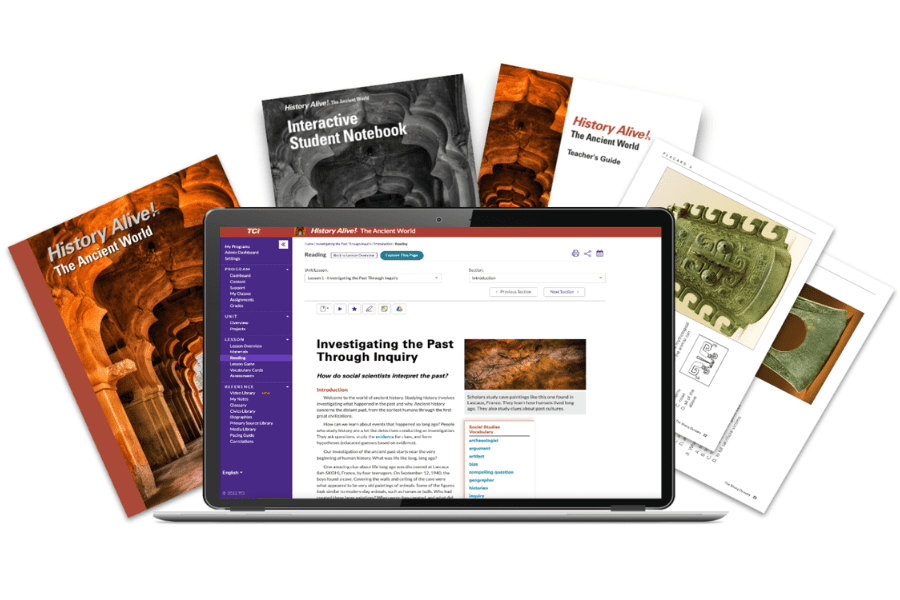
Selecting high-quality instructional materials (HQIM) for social studies is one of the most impactful decisions a district can make. It influences not only student achievement but also teacher effectiveness and overall district success. With the right HQIM, students develop critical thinking skills, engage meaningfully with historical content, and become informed citizens ready to tackle complex societal issues.
By choosing and implementing HQIM, district administrators can drive deeper student engagement, improve academic outcomes, and ensure long-term success in social studies education.
This blog offers a practical guide for district administrators on selecting and implementing HQIM in social studies, detailing how these materials enhance student achievement, promote critical thinking, and prepare students for active civic participation.
Inspired by the eBook, High-Quality Instructional Materials for Social Studies: A Comprehensive Guide for Choosing Curriculum, this blog explores how HQIM elevates social studies education. The series delves into HQIM’s impact on academic performance and civic readiness while providing practical strategies for effective implementation. For further insights, download the full eBook.
How to Evaluate and Compare Social Studies Curricula
The social studies curriculum market is diverse and competitive, with numerous publishers offering a wide range of products. While many providers in the market offer similar features, the quality and effectiveness of these features can vary significantly. District administrators must evaluate how each program aligns with their district’s specific needs and goals.
Common features across many social studies curricula include:
- Standards Alignment: Most curricula claim alignment with state and national standards.
- Digital Components: Many providers offer online platforms or digital resources to supplement print materials.
- Teacher Support Materials: Lesson plans, pacing guides, and professional development resources are often included.
- Assessment Tools: Many curricula include formative and summative assessment options.
- Differentiation Strategies: Materials often include suggestions for adapting content for all learners.
- Primary Source Integration: Many programs emphasize the use of primary sources in instruction.
However, the depth, quality, and effectiveness of these features can differ greatly between providers. While many products appear similar on the surface, the key is to critically evaluate each program’s real impact on student engagement, teacher support, and long-term success in building students’ critical thinking and civic skills.
Making Informed Decisions about Social Studies HQIM
Selecting high-quality instructional materials for social studies has a direct impact on student learning, teacher effectiveness, and overall district performance. The right curriculum does more than meet standards — it shapes future citizens by giving them the tools to think critically, engage with complex issues, and participate in society. Engaging with diverse sources helps students broaden their understanding and prepare to thrive in an interconnected world.
For instance, TCI’s programs weave multiple perspectives into reading and activities through primary source investigations, biographies, and rich videos and images. These materials help teachers tackle tough topics and create a respectful, inquiry-based classroom environment that fosters deep engagement.
5 Implementation Considerations for District Administrators
Successful implementation of HQIM for social studies is more than just a curriculum–it requires planning, communication, and ongoing support. Key considerations include:
- Professional Development: Allocate resources for comprehensive teacher training before and during implementation. Engaging teachers in pre- and post-evaluations ensures they are equipped to deliver the curriculum effectively.
- Technology Infrastructure: Ensure your district can support digital components of the curriculum. The ability to run rich media at speed and without interruption requires robust infrastructure.
- Stakeholder Communication: Develop a plan to inform all stakeholders about the new materials. Communicating with parents and families early ensures smoother transitions and better support for students at home.
- Phased Implementation: Consider a pilot program before full rollout. Create a cross-functional team to ensure the program’s success.
- Ongoing Support: Plan for continuous support and coaching throughout implementation. Continued professional learning opportunities, including time for teachers to collaborate and share data with peers, are essential for long-term success.
By considering these five areas, district administrators can create a solid foundation for successfully adopting HQIM in social studies. Thoughtful planning and ongoing support will ensure that the new materials have a lasting positive impact on student learning and teacher satisfaction.
Best Practices from Districts with Successful HQIM Implementations
The Center for American Progress conducted a study which had additional lessons to share for successful HQIM implementations:
- Show teachers what implementation looks like in the classroom.
- Solicit feedback regularly to adjust implementation as needed.
- Develop a collection of videos to demonstrate implementation for staff.
- Ensure coaches and leaders are prepared and know what to look for.
- Engage all staff in understanding the importance and the use of HQIM.
Throughout the implementation, school leaders, including principals and instructional coaches, drive the implementation of HQIM. The principal, as the decision maker, ensures that:
- Key communications are conveyed to all school staff and aligned to the district’s vision.
- All staff are organized and prepared for implementation.
- All teachers receive HQIM professional development.
- Teachers receive support, such as instructional coaches and opportunities for collaboration, planning, and feedback.
- There is consistent operationalization of HQIM in every classroom.
- A continued process of improvement is in place to increase the fidelity of implementation.
With these best practices in place, HQIM can not only elevate student performance in social studies but also foster a culture of continuous growth and engagement for both teachers and students.
TCI’s Approach: Setting the Standard for High-Quality Social Studies Materials
TCI’s interactive social studies programs are designed to be more than just a curriculum — they are a complete system for engaging students and supporting teachers in inquiry-based learning. In a TCI classroom, students go beyond memorizing dates and facts. They construct arguments, analyze primary sources, interact with images and videos, and participate in rich discussions through TCI’s inquiry-based approach to learning.
Designed to include various learning styles, TCI’s social studies programs feature:
- Research-based instructional strategies
- Integrated technology
- Diverse sources
- Inquiry-based learning
- Comprehensive teacher support
- Flexibility and customization
TCI is also committed to evolving its programs through educator feedback and data-driven improvements, ensuring that the curriculum remains relevant and effective for today’s students.
Implementing new instructional materials is a journey, not a one-time event. District administrators need to plan for ongoing support, continuous evaluation, and iterative refinements to ensure that HQIM continues to meet the needs of students and teachers alike. By prioritizing high-quality social studies materials, districts are investing in the academic and civic future of their students.
Ready to take the next step? Download our comprehensive ebook to explore detailed strategies, practical examples, and actionable insights for selecting and implementing HQIM in your district. Equip your team with the tools they need to make informed decisions that benefit both students and educators.


